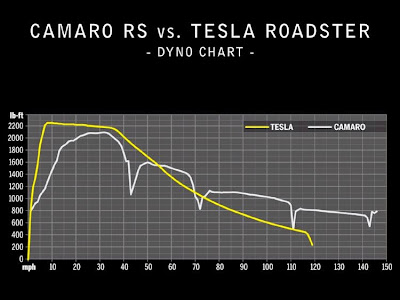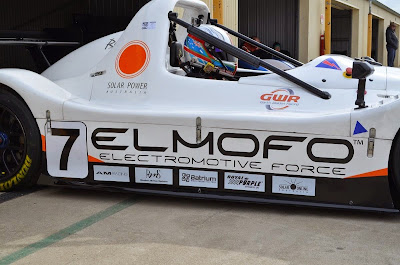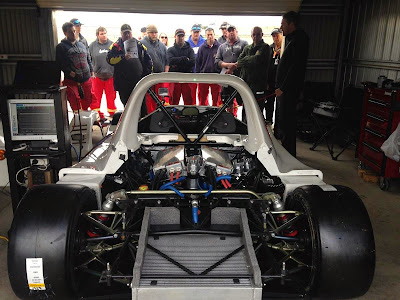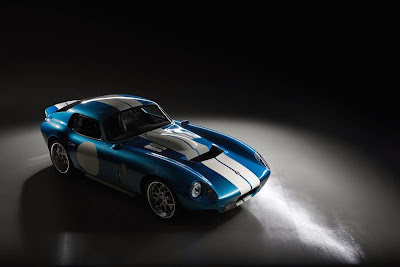A ‘quick’ test drive in a Tesla Model S P85+
Earlier this week EV News had the pleasure of test driving a Tesla Model S P85+ around the streets of Sydney. It was only a very brief experience compared to the week long test drives we've had with most other EVs, but it was long enough to confirm Tesla Motors electric vehicles are in another league.
The first thing you notice about the Model S is that it's a big car. All dimensions including wheelbase and track are larger than a Holden Commodore VF. The upshot of this being the Model S has more interior storage space (1,796 L) than the Mitsubishi Outlander PHEV SUV we tested a few weeks ago. The overall size of the wheelbase seems governed by the size of the flat-pack battery enclosure which makes up 700 kg of the vehicles 2,100 kg kerb weight.
For such a heavy car the weight wasn't noticeable while driving, although the test route didn't allow for any high speed loaded cornering. In acceleration the P85 Model S is stunning! Unlike all other EVs I've driven which have synchronous BLDC permanent magnet motors, the asynchronous AC induction motor in the Model S really has a kick in the back off the line. So much so it might be a good idea for Tesla reps to wear a neck brace on test drives.
The BMW i3 I drove in Munich earlier this year was the fastest EV I had previously driven but full acceleration in the i3 didn't really come on strong until over approx 25 km/h. With 310 kw and 600 Nm peak torque from zero RPM from the 3 phase AC induction motor, the P85 Model S launches from a standing start to 100 km/h in just 4 seconds. That's faster than your average Porsche.
As with all EVs, mid-speed acceleration was impressive but with the Tesla, mind blowingly so! The main reason I've been so keen to sample a Model S was because my daily driver has 255 Kw / 500 Nm with a 1600 kg chassis, so on paper the two are broadly comparable. My 5.7 Lt 4 door sedan does 0-100 km/h in around 5 sec which is faster than both a standard Model S 85 (5.6s) the 60 version (6.2s). I've clocked up over 300,000 km in my current car so am fairly familiar with impressive acceleration, yet the Model S P85 absolutely kills it!
I've been trying to get my head around how the Tesla Model S P85's mid-speed acceleration felt twice as fast as my car. The Tesla's 600 Nm multiplied by the 9.73:1 reduction gear ratio gives 5,898 Nm at the rear wheels. Divide that by the 2,100 kg kerb weigh and the Model S has 2.8 Nm /kg. Running the same numbers for my Corvette engined family sedan gives 4,476 Nm (in first gear only) divided by 1,600 kg kerb weigh surprisingly gives the same 2.8 Nm/kg figure.
So why does the P85 feel twice as fast at mid speed? The 3 phase AC copper rotor induction motor's torque curve gives a flat 600 Nm between 0 and 5,000 rpm. Like with all EVs this broad torque curve allows the Tesla to have a single speed transmission. This means it's effectively in first gear all the time. So while my ICE powered car, even in 1st gear, doesn't reach peak torque until 4,400 rpm (although it has approx 80% of that from 1,500 rpm), cruising in top gear reduces maximum rear wheel torque to 'only' 1,500 Nm at mid-speeds. By comparison, the Tesla has approx 6,000 Nm available from standstill up to approx 70 km/h.
The bottom line is, at mid-speeds, the Tesla has up to 4x as much peak torque available at the flick of the throttle pedal compared to my ICE car and I can confirm, you can certainly feel the difference. The rep spotted the "Tesla grin" immediately. It's no surprise that Mercedes, Audi and BMW are already working on their own versions of the Model S. I don't think it's much of an exaggeration to say this car is revolutionary!
The Model S P85+ as driven was priced around $190k. A basic P85 option package with the full 310 kw / 600 Nm and 21" wheels is $130,600. Unfortunately luxury tax and other government charges add another $25k bringing the total cost to $155k in Australia.
The global market for EV traction motors will be over $25 billion in 2025
The electric vehicle business will approach a massive $500 billion in 2025 with the traction motors being over $25 billion.
Their design, location and integration is changing rapidly. Traction motors propelling land, water and air vehicles along can consist of one inboard motor or - an increasing trend - more than one near the wheels, in the wheels, in the transmission or ganged to get extra power. Integrating is increasing with an increasing number of motor manufacturers making motors with integral controls and sometimes integral gearing. Alternatively they may sell motors to the vehicle manufacturers or to those integrating them into transmission.
In a new report from IDTechEx called "Electric Motors for Hybrid and Pure Electric Vehicles 2015-2025: Land, Water, Air" these complex trends are explained with pie charts, tables, graphs and text and future winning suppliers are identified alongside market forecasts. There are sections on newly important versions such as in-wheel, quadcopter and outboard motor for boats.
Today, with the interest in new traction motor design there is a surge in R&D activities in this area, much of it directed at specific needs such as electric aircraft needing superlative reliability and power to weight ratio. Hybrid vehicles may have the electric motor near the conventional engine or its exhaust and this may mean they need to tolerate temperatures never encountered in pure electric vehicles. Motors for highly price-sensitive markets such as electric bikes, scooters, e-rickshaws and micro EVs (car-like vehicles not homologated as cars so made more primitively) should avoid the price hikes of neodymium and other rare earths in the magnets. In-wheel and near-wheel motors in any vehicle need to be very compact. Sometimes they must be disc-shaped to fit in.
However, fairly common requirements can be high energy efficiency and cost-effectiveness, high torque (3-4 times nominal value) for acceleration and hill climbing and peak power twice the rated value at high speeds. Wide operating torque range is a common and onerous requirement. Overall energy saving over the drive cycle is typically critical. Usually winding and magnet temperature must be kept below 120C and then there are issues of demagnetisation and mechanical strength.
BMW Formula E course cars to be equipped with Qualcomm wireless charging
The all-electric FIA Formula E Championship has today confirmed that its course cars for the inaugural season will be fitted with Qualcomm Halo™ wireless charging technology – an inductive charging system which allows the car’s battery to be charged without the use of cables.
With the final specification of car set to be announced shortly, the championship’s technical team took advantage of today’s final test at Donington Park to trial two BMW i8 and two BMW i3 models with the aim to evaluate them for the series’ official course cars. Earlier this year, the German marque was part of the Global Launch event of the Formula E in London.
All four BMWs have been specifically modified to meet FIA requirements, with one of the BMW i3 models featuring an inductive charging system from Qualcomm Incorporated (NASDAQ: QCOM), with the remaining three vehicles set to be adapted at a later stage. The technology has been developed by San Diego-based Qualcomm Incorporated, one of the official Founding and Technology Partners of the series and a global leader in 3G, 4G and next-generation wireless technologies. The Qualcomm Halo™ technology uses resonant magnetic induction to transfer energy between a ground-based pad and a charging pad fitted to the underside of the vehicle. The cars can then simply park over the base pad for charging to start automatically.
The chosen safety car – which will be officially entitled the Qualcomm Safety Car - will be driven by experienced driver Bruno Correia, whilst the medical and extraction cars will be overseen by FIA Medical Delegate Dr Phil Rayner and his team. The cars will be positioned at the end of the pitlane, charging wirelessly and ready to be rapidly deployed as required during each practice, qualifying and race.
Steve Pazol, GM, Wireless Charging at Qualcomm Incorporated, said: “Qualcomm is honoured to be an integral part of FIA’s Formula E Championship. As electric vehicles become more ubiquitous, charging them wirelessly is an obvious next step in the EV evolution and we are excited to showcase this in Formula E. Motorsport is a known proving ground for new technologies, and in addition to our wireless EV charging technology, Qualcomm will be bringing more of its technologies to bear as the series goes forward.” Alejandro Agag, CEO of Formula E, said: “Qualcomm’s wireless charging system is ground-breaking technology and represents an exciting evolution for charging electric vehicles. Wireless charging has the potential to radically improve the electric vehicle driver experience and Formula E provides the perfect platform in which to develop, test and showcase this exciting new technology.”
Formula E is the FIA’s new fully-electric single-seater championship designed to appeal to a new generation of motorsport fans, whilst accelerating the interest in electric vehicles and promoting sustainability. Competing entirely on city-centre circuits – with races also in China, Malaysia, Uruguay, USA, Monaco, Germany and the UK – it uses cars capable of speeds in excess of 150mph (225kph). Its 10 teams and 20 drivers feature some of the leading international names in motorsport including Alain Prost and Michael Andretti, along with high-profile environmental supporters including Sir Richard Branson.
LG Chem wins battery order from Audi for plug-in hybrid cars [VIDEO]
South Korea's LG Chem said on Wednesday it had won an order from Audi to supply batteries for its plug-in hybrid and micro hybrid electric vehicles.
LG Chem said the deal was "worth hundreds of millions of dollars" but declined to give further details. It said it expected to win more such orders from Audi parent Volkswagen in the future.
LG Chem, which has secured a total of 20 customers including General Motors, also it aims to achieve combined sales of over $10 billion from large-sized batteries by 2018.
LG Chem signs battery deal with Volkswagen [VIDEO]
LG Chem has agreed to supply electric-vehicle batteries to Volkswagen, a company executive said Tuesday.
"Volkswagen has designated LG Chem as one of its key battery-sourcing channels to push its electric car projects," the executive said by telephone on condition of anonymity, citing the sensitivity of the issue. "LG is going to supply battery packs and solutions to the German carmaker."
The deal with Volkswagen is not as big as similar deals between LG and other leading carmakers such as General Motors and Ford, said the executive.
The partnership also involves collaboration on various products the German car manufacturer is working to develop as part of its electric-vehicle projects, part of its efforts to reduce carbon emissions.
For example, Volkswagen is working to attain "ultra-low-carbon mobility" for its new eGolf electric vehicle, said officials.
The vehicle is a fully electric version of Volkswagen's popular Golf.
"LG Chem will join futuristic electric car business projects such as [projects to develop] plug-in hybrid electric vehicles led by the German carmaker thanks to the latest battery deal," said the official.
An LG Chem spokesman declined to confirm.
LG Chem has been in talks with Volkswagen over the past four years regarding a business partnership involving batteries for electric vehicles.
The executive said it was Beijing's approval to proceed with LG's plans to build a battery joint venture in China that helped the LG Group affiliate land the partnership with Volkswagen.
Volkswagen plans to spend more than $2 billion on models and on two new facilities in China, increasing total investments in the world's biggest auto market to nearly $8 billion.
LG Chem Chief Financial Officer Cho Suk-jeh told investors and analysts that the company aimed to generate nearly 2 trillion won in revenue from its large battery business, including energy systems, by 2016.
The petrochemical business is the biggest cash cow for LG Chem, accounting for 77 percent of its 5.87 trillion won in sales in the second quarter. Batteries accounted for 12.3 percent and electronic information materials 12.1 percent.
LG Chem is gradually cutting its reliance on petrochemical products as part of an effort to diversify its revenue sources.
On a related note, in 2016 the company plans to begin providing carmakers with batteries capable of powering electric vehicles for at least 200 miles (322 kilometers).
LG Chem currently supplies lithium-ion batteries to General Motors, Ford, Hyundai-Kia, Renault, Volvo, and other carmakers. The 200-mile-plus range of the new batteries is roughly double that of the company's current, first-generation electric-vehicle batteries.
WORLD FIRST: Electric Racer beats field of petrol powered cars.. twice
With less than 4 weeks to go until the inaugural FIA Formula E race in Beijing China, an electric race car in Australia has already made history.
In what is believed to be a world first, a battery powered Radical SR8 entered by ELMOFO in the NSW SuperSports State Championship has become the first electric car to win a race against petrol vehicles in a sanctioned race event. To prove it was no fluke, it won twice!
Not only did the EV win two of the three races comprising round four of the championship, held 17th August at Wakefield Park Raceway, the ELMOFO Radical, driven by Garth Walden, also set the fastest lap time for the entire meeting (57.6870 sec) beating all other categories which included Formula 3 and Sports Sedans.
The ELMOFO Radical is similar in concept to the current Nürburgring EV lap record, the TMG EV P001 built by Toyota Motorsport GmbH and the TMG EV P002 modified by TOYOTA Racing Development U.S.A. to tackle Pikes Peak in 2013.
The race winning electric Radical SREV was built by Newcastle based Solar PV systems firm Solar Power Australia. The car delivers 280 kw (375 hp) and 570 Nm (428 ft-lbs) of torque almost instantly from its twin sequential BLDC motors. Power is controlled by dual Rinehart Motion Systems inverters which are fed voltage from a 37 kWh lithium ion battery pack controlled by a Batrium BMS. Power is transmitted to the rear wheels via a single speed limited slip differential. Performance specs for the all-electric racer, built on a Radical SR8 chassis, include 0 to 100 km/h (62 mph) in 3.5 seconds, 0 to 160 km/h (100 mph) in 6.5 seconds with a top speed of 265 km/h (165 mph).
The 2014 CAMS NSW SuperSports Championship is mostly a one-make series for Radicals, with a couple of Stohr WF1 single seaters also contesting the series. The ELFOMO team have worked hard over the previous three rounds to debug the car and the wins are a just reward for achieving solid reliability. Since the beginning of the season the car has demonstrated it had raw speed by routinely qualifying on the front row of the grid. In only round 4 of the championship the battery powered racer dominated from the front with Walden blasting well ahead of the pack for the first 4 or 5 laps and then backing off a little to preserve the car.
The ELMOFO team would like to thank Rinehart Motion Systems, AM Racing, Batrium, Garth Walden Racing, Royal Purple and the Supersports Racecar Club Committee who have been very supportive of the car, scheduling some races of a length that the battery powered vehicle could complete to ensure it’s inclusion in the series.
Silicon Valley startup Renovo Motors unveil $529,000 EV supercar [VIDEO]
When they started their company in 2010, the founders of Silicon Valley startup Renovo Motors saw a hole in the market for a pure electric supercar.
Today they revealed their first product, the $529,000 Renovo Coupe, scheduled to launch in the United States next year.
Performance specs for the all-electric two-seater, built on the Shelby CSX9000 chassis, include 0 to 60 mph in 3.4 seconds, with a top speed of 120 mph. The company says the car will deliver 370 kw (500 hp) and 1,356 Nm (1,000 ft-lbs) of torque almost instantly from its twin sequential axial flux motors. Power is controlled by dual RMS inverters which are fed high-voltage from a 740 volt lithium ion battery pack, with output power transmitted to the rear wheels via a single speed differential.
After developing the car in secrecy for the past four years, Renovo launched the running prototype last weekend at the Pebble Beach Concours d’Elegance. The company plans to begin taking orders for a production run of less than 100 cars, with the first cars due to be delivered in California next year.
Renovo’s founders, Christopher Heiser and Jason Stinson, previously worked at the computer security company Verisign and chipmaker Intel. Though they are new to the industry, they hope to find space in the supercar market alongside venerable names such Ferrari and Lamborghini, and relative newcomers such as Pagani and Koenigsegg.
Though many luxury brands and exotic car companies are starting to offer plug-in hybrids and pure EVs, including Ferrari and McLaren with their LaFerrari and P1, Heiser said in an interview Thursday that no one offers a product like the Renovo Coupe. That includes their Silicon Valley neighbor and inspiration of sorts, Tesla Motors Inc., which stopped selling its Roadster sports car in 2012.
Source: Renovo Motors
Tesla Model S Drive Unit now has Infinite Mile Warranty
Following recent negative reports about Tesla Model S drive unit reliability, Tesla has increased the Model S drive unit warranty to match that of the battery pack. That means the 85 kWh Model S, the most popular model by far, now has an 8 year, infinite mile warranty on both the battery pack and drive unit. There is also no limit on the number of owners during the warranty period. Moreover, the warranty extension will apply retroactively to all Model S vehicles ever produced.
The drive unit is now covered under the same provisions as the existing battery warranty, so owners with an 85 kWh battery will benefit from eight years of coverage with no mileage restrictions, while 60 kWh owners have up to 125,000 miles.
The drive unit issue, described as a grinding or “milling” noise that increases over time, was picked up by Motor Trend Magazine who reported that they had to have a drive unit replaced in their Model S. The issue really hit the headlines when Edmunds reported they are on their 4th drive train.
Tesla had transmission issues with the Roadster. The two-speed transmission designed for the Roadster by a previous supplier proved not to be durable so in 2008 Tesla Motors selected BorgWarner for the production of a single-speed gearbox.
The source of the current 9.73:1 Model S gearbox is not known. Anecdotal evidence suggests the Borg Warner eGearDrives supplied for the the Ford eTransit Connect has quite a high failure rate but as the Model S transmission casting is integrated with the AC Induction motor enclosure and without knowing which component has suffered premature wear, it's too early to attribute blame for the design fault.
When you take into consideration how common transmission failures are within the automotive industry and how high performance the Tesla Model S is, it's not so surprising to find the powertrain needs some mechanical debugging. For example, Subaru have been making the Impresa WRX since 1992 and after two decades in production they're still prone to transmission failure. The only sure way to avoid mechanical transmission issues is to not have one by using direct drive wheel motors.
The standard warranty for Tesla Model S is 4 year, 50,000 mile (80,000 km). In April last year Tesla announced an unlimited "no-fault" battery warranty. Elon Musk says that in hindsight, the infinite warranty should have been policy for the powertrain from the beginning of the Model S program. If they truly believe that electric motors are fundamentally more reliable than gasoline engines, with far fewer moving parts and no oily residue or combustion byproducts to gum up the works, then the warranty policy should reflect that.
























